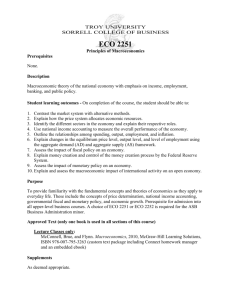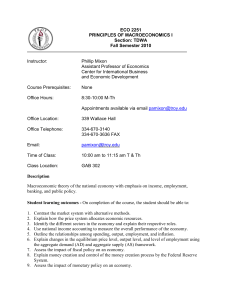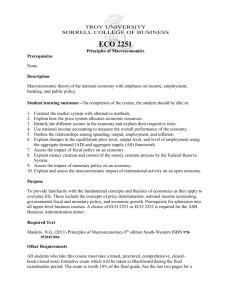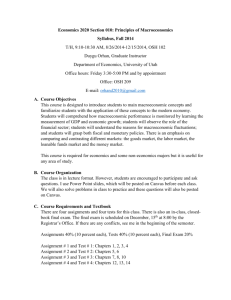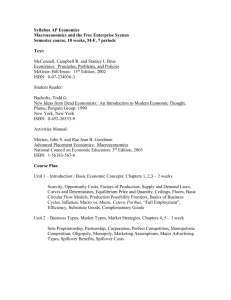AP Macroeconomics - Home
advertisement
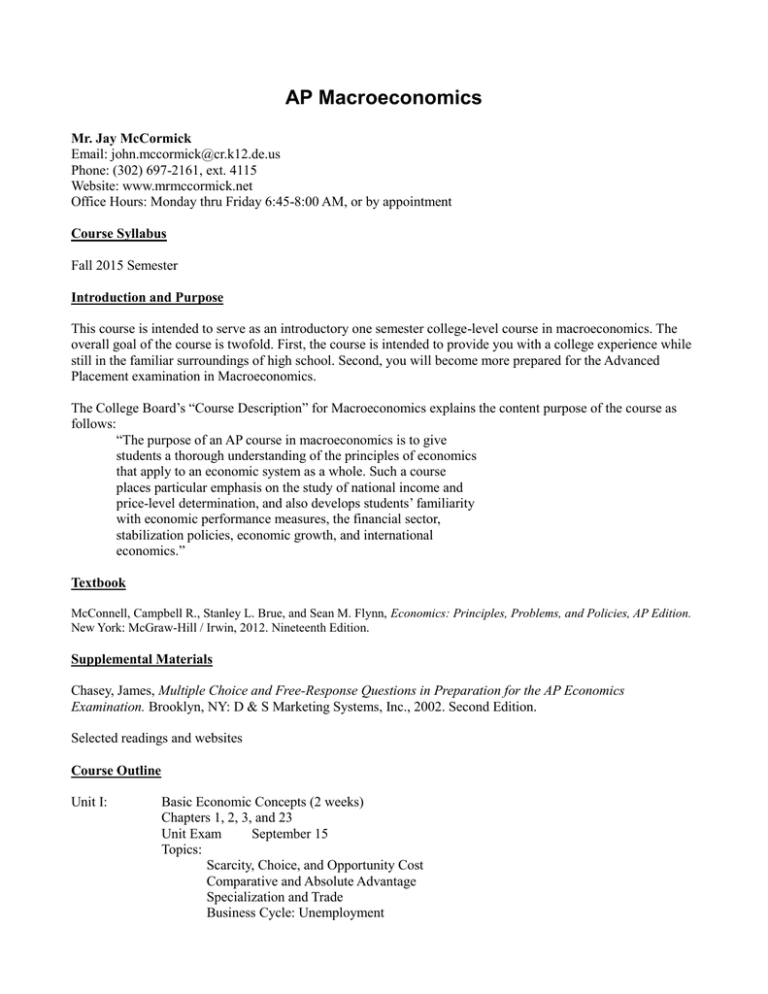
AP Macroeconomics Mr. Jay McCormick Email: john.mccormick@cr.k12.de.us Phone: (302) 697-2161, ext. 4115 Website: www.mrmccormick.net Office Hours: Monday thru Friday 6:45-8:00 AM, or by appointment Course Syllabus Fall 2015 Semester Introduction and Purpose This course is intended to serve as an introductory one semester college-level course in macroeconomics. The overall goal of the course is twofold. First, the course is intended to provide you with a college experience while still in the familiar surroundings of high school. Second, you will become more prepared for the Advanced Placement examination in Macroeconomics. The College Board’s “Course Description” for Macroeconomics explains the content purpose of the course as follows: “The purpose of an AP course in macroeconomics is to give students a thorough understanding of the principles of economics that apply to an economic system as a whole. Such a course places particular emphasis on the study of national income and price-level determination, and also develops students’ familiarity with economic performance measures, the financial sector, stabilization policies, economic growth, and international economics.” Textbook McConnell, Campbell R., Stanley L. Brue, and Sean M. Flynn, Economics: Principles, Problems, and Policies, AP Edition. New York: McGraw-Hill / Irwin, 2012. Nineteenth Edition. Supplemental Materials Chasey, James, Multiple Choice and Free-Response Questions in Preparation for the AP Economics Examination. Brooklyn, NY: D & S Marketing Systems, Inc., 2002. Second Edition. Selected readings and websites Course Outline Unit I: Basic Economic Concepts (2 weeks) Chapters 1, 2, 3, and 23 Unit Exam September 15 Topics: Scarcity, Choice, and Opportunity Cost Comparative and Absolute Advantage Specialization and Trade Business Cycle: Unemployment Business Cycle: Inflation Business Cycle: Economic Growth Supply and Demand and Equilibrium Unit II: Measurement of Economic Performance (2 ½ weeks) Chapters 24, 25, 27, and 28 Unit Exam October 6 Topics: Gross Domestic Product: Creation Gross Domestic Product: Uses Gross Domestic Product: Real v. Nominal Real v. Nominal GDP Expenditures Approach: C and Ig Expenditures Approach: G and Xn Income Approach National Income to GDP Net Domestic Product National Income, Personal Income, and Disposable Income Circular Flow: Market and Economy Calculating CPI, RGDP, and GDP Deflator Consumption and Saving Aggregate Expenditures Graph Marginal Propensity to Save and Marginal Propensity to Consume The Spending-Multiplier Concept Investment Demand and Equilibrium GDP Equilibrium GDP: C + Ig Unit III: National Income and Price Determination (2 ½ weeks) Chapters 29 and 35 Unit Exam October 22 Topics: Equilibrium GDP: Net Exports and Government Expenditures Taxation and the Balanced-Budget Multiplier Aggregate Demand: How Derived, Determinants, and Shifts Aggregate Supply: How Derived, Determinants, and Shifts Macroeconomic Equilibrium: Real Output and Price Level Short-Run Aggregate Supply Long-Run Aggregate Supply Unit IV: Financial Sector (3 weeks) Chapters 31, 32, and 33 Unit Exam November 18 Topics: Financial Assets Time Value of Money Creation of Money and Measures of Money Supply Federal Reserve System Determinants of Money Demand Money Market Equilibrium Role of the Equilibrium Interest Rate Determinants of the Equilibrium Interest Rate Money Market v. Loanable Funds Market Tools of the Central Bank Quantity Theory of Money Monetary Policy: Real Growth and Inflation Unit V: Inflation, Unemployment, and Stabilization Policies (4 weeks) Chapters 26, 30, and 35 Unit Exam December 14 Topics: Fiscal Policy and Aggregate Demand Monetary Policy and Aggregate Demand Fiscal Policy and Aggregate Supply Monetary Policy and Aggregate Supply Fiscal and Monetary Policy: Affect on Output and Price Level Short Run without any Fiscal or Monetary Changes Long Run without any Fiscal or Monetary Changes Short and Long Run Affects of Fiscal and Monetary Policies Effect of Government Budget Deficits Creation of the National Debt Deficit, Interest, and Inflation Phillips Curve and Unemployment v. Inflation Demand-Pull Inflation Cost-Push Inflation Economic Expectations of Inflation Unit VI: Economic Growth and Productivity (1 ½ weeks) Chapter 25 Unit Exam No Separate Exam (Combined with Unit VII) Topics: Development of Long Run Economic Growth Productivity and Real Output Investment: Human Capital v. Physical Capital Investment: Research and Development and Technology Public Policy and Long Run Economic Growth Unit VII: Open Economy: International Trade and Finance (2 weeks) Chapters 25, 37, and 38 Unit Exam January 15 Topics: Goods Market v. Financial Market Current Account Balance v. Capital Account Balance Trade Balance and the Foreign Exchange Market Equilibrium Exchange Rate Market Forces and Public Policy: Currency Demand and Supply Currency Appreciation and Currency Depreciation Capital Flows and Net Exports: Effect on Financial Goods and Markets Effect of Restrictions and International Payments on Trade Effect of Domestic Policy on Trade and Exchange Rates Grading Procedure In this course your assignments will be broken into 3 main categories: Tests (which includes quizzes), Projects, and Free-Response Questions (FRQ). The weight for the various areas is as follows: Tests: Projects: FRQs: 60% 15% 25% Tests Units I, II, III, IV, and V will culminate with a test consisting of 20 multiple choice questions and either one or two free-response questions. Because Units VI and VII are so short, they will be combined to form one regular length test. The questions on all tests are cumulative and may require application of knowledge gained in previous units. Other quizzes may be added as needed. Projects During the course of both marking periods you will be expected to complete a major project. The purpose of these projects is to apply the knowledge gained in class to real situations. Both projects will require extensive research. The nature of the projects will change from year to year depending on the nature of the global economy. Free-Response Questions In addition to a cumulative test, each unit will also include an FRQ-exclusive assessment. This will be given in the middle of the unit to monitor your understanding of the material prior to the end-of-unit test. Some of the questions will require the application of knowledge gained in previous units. Make-Up Work It is the responsibility of the STUDENT to arrange for a time to complete make-up work due to an absence. YOU WILL HAVE ONE WEEK TO MAKE UP AN ASSIGNMENT. AFTER THAT TIME THE GRADE WILL BECOME A ZERO. If you have an extended illness or permission from the instructor, this timeline may be extended. The best time to complete make up work is from 7 AM to 8AM, but this should still be arranged with the instructor prior to arriving to avoid conflicts. (*NOTE: This is subject to change based on application of PLC to the Staff Workday.) After school appointments can be made as necessary. Marking Period Grades Although this is an Advanced Placement course, your marking period grade will be based on the Caesar Rodney School District scale as follows: A = 92%-100% B = 85%-91% C = 75%-84% D = 70%-74% F = Below 70% Course Grades This is a half year course. Therefore, you will be graded based upon the Caesar Rodney School District scale for half year courses as follows: First M.P. = 40% Second M.P. = 40% Final = 20% The AP Exam The Advanced Placement Macroeconomics exam will be given at 12:00 PM on Wednesday, May 11, 2016. The following description of the exam comes from the College Board’s “Course Description” for Macroeconomics: “The … AP Macroeconomics Exam [is] a little over two hours long. [The] exam consists of a 70 minute multiple choice section and a 60 minute free response section. Some questions in the free response section require graphical analysis. The free response section begins with a mandatory 10 minute reading period. During this period, students are advised to read each of the questions, sketch graphs, make notes, and plan their answers. Students then have 50 minutes to write their answers. The multiple choice section accounts for two-thirds of the student’s exam grade and the free-response section for the remaining one-third.” Free Response: -One-third of exam score -60 minutes for all (10 minutes for reading, 50 minutes for response) -One long essay (50% of the free response score) -Two short essays (together totaling 50% of the free response score) Multiple Choice: -Two-thirds of exam score -70 minutes -60 questions -Percentage of questions asked by unit area: -Basic Economic Concepts (8-14%) -Supply and Demand (15-20%) -Theory of Consumer Choice (5-10%) -Production Costs (10-15%) -Firm Behavior and Market Structure (25-35%) -Factor Markets (10-18%) -Market Failures and the Role of Government (12-18%) The registration date for the exam will be announced at a later date, but is typically in March.

